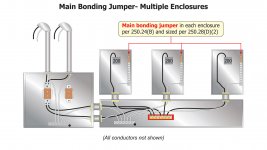Couldn't find a Mike Holt graphic for this - pardon me 
In the scenario with 2 or more separate service disconnecting means, each with N-G bonding, we will have current flowing on the neutral and the enclosures / metallic raceways under normal and fault conditions, correct? Even worse if one disco is 5-10 ft away due to wall space. Never really noticed that since I always deal with service switchboards.
Cheers!
In the scenario with 2 or more separate service disconnecting means, each with N-G bonding, we will have current flowing on the neutral and the enclosures / metallic raceways under normal and fault conditions, correct? Even worse if one disco is 5-10 ft away due to wall space. Never really noticed that since I always deal with service switchboards.
Cheers!

